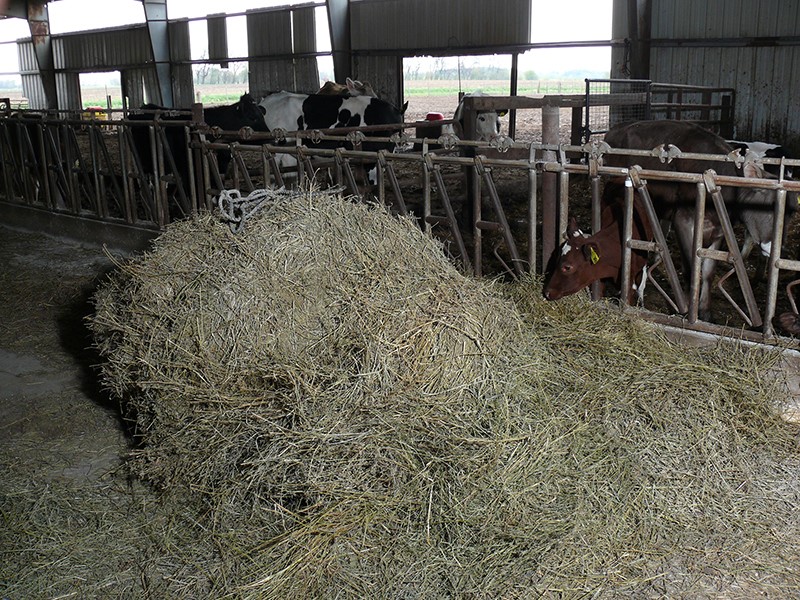Late-harvested forages may not provide adequate nutrition over winter for gestating or lactating livestock; options still available for unharvestable corn.

Purdue University Extension specialist Keith Johnson is warning livestock owners that forage they harvested earlier this year likely has lower-than-usual nutritional quality, and without proper supplements, there could be serious consequences for their animals.
“This is a very unusual year, and the quality is extremely low for this late-harvested forage,” said Johnson, a professor of agronomy and extension forage specialist at Purdue. “We have less energy and protein with a more mature crop. There’s a crisis potentially brewing if people don’t pay attention to quality.”
Nutrition issues will be significant with cool-season grasses such as tall fescue, orchardgrass, smooth bromegrass, timothy and perennial ryegrass as well as legumes such as alfalfa or red clover. Growers usually harvest these forages for the first time in mid- or late-May, but the particularly wet spring in the Midwest kept them out of the fields until late June to early July, the announcement said.
As forage crops mature, their fiber and lignin content increase, making them less digestible, which means a reduced nutrient supply to the animal. Dry matter intake potential is also compromised with a high fiber content.
Improper nutrition can lead to weight loss, weakness, poor lactation, poor conception or a lengthened birthing period. Proper nutrition is important for any animal, but it is especially critical during late gestation and lactation, according to the announcement.
Johnson said it’s important for livestock producers to have their forage professionally tested and then use the results to work with a trained nutritionist to develop a nutrition plan. Nutritionists may recommend adding soybean hulls, soybean meal, corn, distillers grains, corn gluten feed or other supplements to raise the nutritional quality, he suggested.
“It’s critical that you work with certified laboratories and trained nutritionists who have the expertise to really dial in the proper nutrition for your animals,” Johnson said.
He said the National Forage Testing Assn. website lists proper hay and forage sampling methods.
Unharvested corn
Meanwhile, North Dakota State University (NDSU) Extension livestock specialists noted that due to the late corn planting season in the northern Plains, combined with cooler temperatures, many fields are unable to be harvested, or it is not cost effective to harvest corn for grain, especially with late-season varieties.
Alternative uses for corn include grazing, chopping it, harvesting as earlage or harvesting high-moisture corn to be used for livestock feed, they said, but producers must take precautions when grazing unharvested corn to ensure that animals don’t develop health issues.
“When grazing standing corn with cobs that are filled with grain, the grazing has to be managed to reduce any risk of causing health issues and even death to livestock,” NDSU Extension rangeland management specialist Kevin Sedivec cautioned. “Consuming too much grain can cause digestive upsets (acidosis), lameness, abortions and death, in extreme cases. Some issues will develop through time, making them difficult to detect.”
Before turning cattle out to graze standing corn, they should be allowed to adapt to a higher-grain diet to reduce the risk of acidosis or other digestive disorders, the NDSU announcement said.
“It is important to control the amount of corn and forage to which the animals have access,” NSDU Extension livestock environmental stewardship specialist Miranda Meehan said. “You can effectively do this by cross-fencing or grazing in controlled strips. This technique will reduce high overload of grain and waste through trampling.
“Cross-fencing and strip-grazing are usually recommended with access to no more than a two-day supply of fresh corn at a time; a one-day supply is even better, especially for younger, growing cattle,” she said. “If you cannot limit feed grazing animals in standing corn, this option is not recommended, because the risk for high death loss is great.”
Another option for unharvested corn the NDSU specialists suggested was to chop the corn, but they noted that achieving “true” silage likely will be impossible without adding water to the pile. In areas that have already experienced a killing freeze, corn will be too dry to harvest as silage.
"The whole corn plant is probably running at 25-45% moisture and even up to 60%, so harvesting as silage is still an option,” said Karl Hoppe, extension livestock systems specialist at NDSU’s Carrington Research Extension Center. “Silage that is below the recommended moisture content (65-75%) still should be chopped finer and packed repeatedly to remove as much oxygen from the pile, but it will not fully ferment; thus, it is susceptible to spoilage.”
Hoppe noted, “Producers also have chopped corn that was frozen and stored frozen. This feed, if it remains frozen, will make good feed. However, frozen whole-plant chopped corn, when it thaws, will spoil next spring. So, plan to harvest only what you can feed this winter season.”
Earlage is ensiled corn grain, cobs and, in some cases, husks and a portion of the stalk, NDSU said. Earlage allows the production of a relatively high-energy feed product that can be harvested, stored and fed much like corn silage using the same types of equipment that are used to produce corn silage.
Earlage is higher in energy than corn silage and has a similar protein content, but it is lower in energy than dry or high-moisture corn grain, NDSU said. Earlage is harvested at 35-40% moisture and packed and stored like silage. At harvest, cob material will be higher in moisture than grain. With earlage, the biggest problem usually is harvesting the corn when it is too dry.
About the Author(s)
You May Also Like

.png?width=300&auto=webp&quality=80&disable=upscale)

